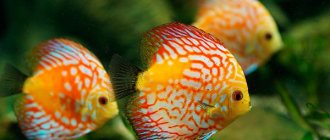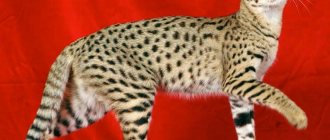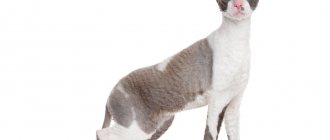No matter how you feel about snakes, they are nature's most amazing creatures. These creatures are both frightening and fascinating with their appearance. The richness and variety of colors of a snake’s skin can be the envy of any modern fashionista. In addition, there are whole legends about the dexterity and strength of some species. Even in ancient times, snakes were endowed with magical and even divine powers; they were feared and considered wise demonic creatures. In our review we will talk about the largest snakes on the planet.
Reticulated python
The reticulated python is an impressively sized snake. The average length of this python is six meters. There are documents proving that one of the representatives of these reptiles named Samantha, who lived in captivity, had a length of 7.5 meters. The reticulated python perfectly hunts small artiodactyls, domestic animals, monkeys, and birds. For humans, such a python is very dangerous, as it has enormous strength and is also very aggressive.
Amethyst Python
This representative of the snake kingdom is protected by Australian law. The largest snake on the Australian continent , which includes the amethyst python, reaches almost 8.5 meters in adulthood and eats up to 30 kg.
On average, a snake’s height does not exceed 3 m 50 cm. Among its relatives, pythons, it stands out for its symmetrical and noticeably large scutes located on the upper zone of the head.
A serpentologist will understand that this is an amethyst python by the peculiar coloring of its scales:
- olive-brown or yellow-olive color dominates, complemented by a rainbow tint;
- clearly defined black/brown stripes across the body;
- on the back there is a clear mesh pattern formed by dark lines and light spaces.
This Australian reptile shows a gastronomic interest in small birds, lizards and small mammals. The most arrogant snakes choose their victims among bush kangaroos and marsupial cuscus.
This is interesting! Australians (especially those living in the outskirts) know that the python does not hesitate to attack their pets: from afar, the snake feels the warmth emanating from warm-blooded animals.
To protect their animals from the amethyst python, villagers place them in enclosures. Therefore, in Australia, not only parrots, chickens and rabbits are kept in cages, but also dogs and cats.
Anaconda
In second place in our ranking is the anaconda. Anaconda is a snake that prefers the water element. When the name of this snake is mentioned, many people conjure up images from horror films featuring an anaconda of incredible size. But in reality, the recorded maximum length of an anaconda is 5.2 meters, but eyewitnesses claim that there are anacondas 7 meters long. There are suggestions that larger anacondas exist. But it is impossible to confirm this theory due to the impassability of the terrain where these reptiles live, and the anaconda lives in South America. This snake preys on smaller snakes, birds, reptiles and mammals.
Anaconda Deschauensei
Deschauenseei's Anaconda or Dark-spotted Anaconda (Eunectes deschauenseei) weighs on average 30 kg. It is named after Rodolphe Meyer de Schauensey. In 1924, he donated the first dark-spotted anaconda ever captured to the Philadelphia Zoo. This is a non-venomous species of boa found in the swampy areas of northeastern South America. The dark spotted anaconda can grow up to 3 meters in length. Like most other Anacondas, this species loves water and is an excellent swimmer. Their habitat is currently under threat due to agricultural expansion in the region.
Hieroglyphic python
The hieroglyphic python is one of the largest and most impressive snakes in the world. It has a second name - rock python. The length of this python can reach up to 6 meters and weight up to 100 kg. The hieroglyphic python's habitat is the jungles of Africa, but it can also be found in tropical forests and savannah. This python is worth noting as an excellent swimmer, and it is also an excellent tree climber. The active time of day is night. A wonderful hunter. For humans, the rock python is very dangerous, as it has an impressive size and a very aggressive disposition. There are not isolated cases of a python attacking a person.
Indian python or light tiger python
Reaches 6 meters in length.
Indian python
A light tiger python differs from a dark one by the presence of so-called light “eyes” in the centers of the spots, which are located on the sides of the body, as well as by the reddish or pink color of the stripes on the sides of the head. In general, this subspecies is smaller than the dusky tiger python. Large individuals can grow up to only 6 meters.
Tiger dark python
Tiger dark python - in our rating we gave this snake the fourth place of honor. The average length of this python reaches 3.7 meters. Although in the wild the length of such pythons reaches 7 meters. In captivity, the longest tiger python grew to 5.7 meters and had the wonderful name “Baby”. The tiger python is most often found in Indochina, Vietnam, Thailand, India and Cambodia. Although a representative of this species accidentally found its way to Florida and took root there remarkably well. Preys mainly on birds, small reptiles and rodents.
Gyurza
This representative of giant vipers does not have the most impressive dimensions. It can grow up to 2 meters in length, and its weight does not exceed 3 kg. But this does not prevent her from being one of the most dangerous to humans. Gyurza has a lightning-fast reaction and an incredible ability to rush at his target, covering a distance of 2 meters in one jump. Even experienced snake catchers sometimes cannot cope with this poisonous beast, since it is quite difficult to hold its muscular body in your hands.
The distribution area of the viper is extensive; it can be found in the countries of the former Soviet Union, in many Asian countries, on the African continent and some other places.
Common boa constrictor
The common boa constrictor is one of the largest and most impressive snakes on the planet from the family of pseudopods. There are about ten species of boa constrictors in the world. In the wild, the length of such a boa constrictor averages 5.5 meters. The common boa constrictor tolerates captivity remarkably well, so representatives of this species can often be found in terrariums. The habitat of boa constrictors in the wild is South and Central America. They can also be found in Florida and the Lesser Maltese Islands. Depending on the habitat, each subspecies has its own color. Boas are not poisonous, and immobilize their prey using a special strangulation technique.
Black Mamba
The African inhabitant of savannahs and woodlands cannot boast of a very large size. Its length on average does not exceed 3 meters, its weight is usually about one and a half kilograms. There are larger specimens, but they are extremely rare.
Despite its relatively modest size, this aggressive snake inspires fear among local residents, as it is one of the most poisonous on the planet. In addition, it is distinguished by its ability to develop a speed that is phenomenal for a snake - more than 11 km/h. The bite of a black mamba is fatal to humans. Death can occur in less than an hour.
King cobra
The king cobra is the queen among poisonous reptiles. There are individuals up to 5 meters long. Considering the danger of the king cobra, its appearance is impressive. This snake lives mainly in tropical forests of Asia. The main distinguishing feature of this species is the hood at the top of the head. The cobra climbs trees well, but prefers to spend more time on the ground, in quiet, secluded places. The king cobra is very dangerous to people. A small amount of poison will cause death in 15 minutes.
Surukuku
Another name for this poisonous snake is bushmaster. It lives mainly in the tropical forests of South and Central America. Surukuku grows no more than 4 meters in length, weight can vary from 3 to 5 kg. This snake is distinguished by a timid character and a love of solitude, which is why human encounters with it occur infrequently. There have been only 25 recorded cases of surukuku attacks on people, 5 of which resulted in death. Its usual menu consists of rodents, birds, and lizards. The bushmaster will not disdain another snake. Thanks to its enviable endurance, the surukuku can lie in ambush for several weeks while waiting for suitable prey.
Black Mamba
The black mamba is a dangerous, poisonous and most impressive snake in the world, which is one of the ten largest and largest snakes on the planet, up to 3-4 meters long. The snake's mouth is black, which gives it its name. The black mamba lives in Africa in semi-arid places. In addition to its poisonousness, this snake is distinguished by its swiftness. In an attacking throw, she jumps at speeds of up to 20 km/h. The bite of a royal mamba causes paralysis and respiratory arrest.
In conclusion, I would like to note that each species of large snakes represented has at least one human life. Therefore, it is best to observe them in terrariums or in pictures. In our review, we presented the TOP of the largest and largest snakes in the modern world. Of course, it is not necessary to meet them, but we hope that you were interested in learning about the largest representatives of reptiles in the world.
The largest snake on the planet
Titanoboa is perhaps the largest snake in the entire history of our planet. The length of this giant was thirteen meters, although some experts say fifteen; the weight of the reptile sometimes reached a ton. Titanoboa was discovered quite recently, during excavations in a coal mine near a town in Colombia. The largest snakes in the world, photos of which we will never see in our lifetime, were found in a mine that hundreds of millions of years ago was the mouth of a large reservoir. Along with the fossilized skeleton of a giant reptile, the mine contained the skeletons of many previously unknown fish and turtles. Having studied their find in detail, the experts realized that they were facing a real sensation.
According to scientists, this reptile belongs to the family of pseudopods, the same class as anacondas and boa constrictors. The skeleton of this giant really resembles pseudopods, but, as many scientists say, it seems so only at first glance, and insist on including the extinct reptile in its “own” family.
It is curious that these giants appeared after the dinosaurs became extinct. Probably, at that time, these reptiles were the largest among predators, replacing the tyrannosaurs.
On land, it was very difficult for Titanoboa to move at speed, so it did not pose any serious threat to animals capable of running. But in water, Titanoboa was very, very dangerous. Now it is difficult to establish whether she ate crocodiles or alligators, but we can say with confidence that she was able to cope with them.
Like its modern brethren, titanoboa was not poisonous, but acted with its victims like a boa constrictor - first it wrapped itself around and then squeezed.
I wonder if a creature of this size would simply die in our climate. This is why this snake is so interesting in scientific circles. To maintain vital functions, a thirteen-meter reptile needs a temperature of 30-35 degrees. Apparently, sixty million years ago this was exactly the temperature that reigned on Earth.
Unpleasant encounters in the “green hell”
Stories about the existence of huge snakes in an endless “green hell” first began to be heard after the arrival of Spanish and Portuguese conquistadors and travelers in America, but only in the 20th century did the first reliable reports of encounters with these reptiles appear.
In the late 1940s, the director of the Hamburg Zoo, Lorenz Hagenbeck, the son of the famous animal catcher and trader Karl Hagenbeck, conducted the first research on materials about mysterious creatures and came across the story of the priest Victor Heinz, who crossed the Amazon several times in a canoe.
The first meeting took place on May 22, 1922, near the settlement of Obid os. Just 30 meters away, the priest suddenly saw a huge snake being carried by the current. The rowers immediately dropped their oars, frightened by the size of the reptile: about 25 meters in length, as thick as a vegetable oil barrel.
“When we were far enough away,” says the priest, “and my rowers regained the power of speech, they, still afraid, told me that the snake did not crush us like a simple box of matches only because at that moment it was busy digesting a good portion fish".
A few years later, on October 29, 1929, the missionary again encountered a giant snake on the same river. It was midnight when his rowers suddenly, in great fear, began to turn the canoe towards the shore, shouting that they saw a huge animal.
“At that moment I noticed how the water near us receded, as if allowing a large steamer to pass, and I saw, just a few meters ahead, two green-bluish lights, reminiscent of the bow lights of a river boat.” When he tried to reassure the people, saying that it was just a ship and that it could not hit their canoe, he was told that it was a giant snake.
Father Heinz froze in horror, realizing that the lights were the glowing eyes of a creature that was approaching their canoe at a speed 10-15 times faster than their own. When it seemed that the monster was ready to ram the side, it suddenly dodged and seemed to be heading back to the middle of the river. Later, local residents informed the priest that a giant sukuriyu lived in this river.
Not even a few months had passed when the trader Reymondo Zima, who lived in the small village of Faro on the banks of the Hamunda River, came across another specimen of a huge reptile. The animal he met was probably wounded, since only one of its eyes shone in the darkness of the night. For several seemingly endless minutes, it circled at high speed around the frightened merchant's ship, raising waves so high that they threatened to sink the ship, despite its length being 13 meters.
A few years later, in 1948, a certain Pablo Tarvalho claimed that a giant snake had been chasing his barge for a long time. According to him, the snake, which he observed at a distance of approximately 300 meters, had a truly fabulous length - 50 meters!
Sometimes some brave explorers, forgetting about fear, dared to approach these mythical creatures.
The missionary Prothesius Frikel, while traveling along the banks of the Trombetas River in its upper reaches, met one monster, which, while resting, stuck its head out onto the shore.
Showing undoubted courage, the holy father approached the monster at a distance of “some six steps. Only a small part of his body and his head protruded from the water, on which one could see his eyes, “big as saucers.”
Intrigued both by his own encounters and by the stories he had heard from others, Father Heinz sent a report of his observations along with two photographs to the director of the Hagenbeck Zoo in Hamburg.
One of them was made in 1933 by members of the Brazilian Border Commission, who claimed that they killed the animal with several bursts from a machine gun.
According to their testimony, the animal was so huge (approximately 9 meters in length) that even four people could not carry its head and that, falling, it broke several bushes and trees.
Another photo was taken in 1948. It shows the remains of a snake that appeared in the vicinity of Fuerte Abuna, in the Ecuadorian region of Guapore. To destroy the monster, the soldiers used a machine gun, from which they fired at least five hundred rounds - and the expenditure of ammunition was clearly worth it, considering that the animal encountered reached 35 meters in length.











